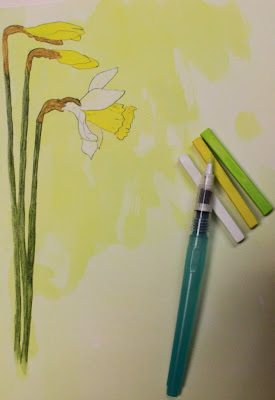Daffodils – Narcissus species and hybrids
“A house with daffodils in it is a
house lit up, whether or no the sun be shining outside. Daffodils in a green
bowl – and let it snow if it will.” – A. A. Milne
Daffodils, one of the first flowers
of spring, are a large group of perennial plants which grow from bulbs. Many hundreds of varieties are available
today ranging in size from 4 to 20 inches (10-50 cm) tall. Flower size can be
anywhere from a half inch to five inches (1-13 cm) in diameter. Daffodils come in various combinations of
pale and bright yellows, white, cream, shades pink, salmon, apricot, orange and
green. Flowers are most often single, consisting of the corona (cup or trumpet)
and perianth (outer petals), but there are double flower varieties in which the
corona is filled with ruffles. Some
varieties are fragrant (most notably the jonquils), while many others have no
scent. Stems may hold one large blossom, or clusters of two to six smaller flowers.
Daffodils were once a symbol of
death. The ancient Greeks associated the flower with the myths of Narcissus and
Pluto and Proserpina. The ancient Egyptians placed the brown skins of the bulbs
over the eyes of the Pharaohs in burial. It was during the Middle Ages that the
daffodil became a Christian symbol of Christ’s resurrection and the promise of
eternal life. In Victorian times, the Language
of Flowers was a popular way to send messages to friends and suitors. The
daffodil represented regard and the jonquil stated, “I desire a return of
affection.” The narcissus is also well
loved in Asia. In China it is regarded as a sacred flower and symbolizes purity
and promise. For the Japanese, the narcissus represents mirth and joyousness.
You can read lots more about daffodils in the rest of Susan's article which you can download. Or go to Susan's blog.
Journal Tutorial
Technique:
Using water soluble pencils and Niji Waterbrushes to create colored pen and ink
style drawings.
Materials:
Journal
Copyright
free image, black and white photocopy of desired subject or your own drawing
Water
soluble pencils (I am using a combination of Derwent Graphitint and Tinted
Charcoal pencils and Inktense blocks)
Niji waterbrush (Added by Bernice: If you don't have one of these or the Ranger one then use a small paintbrush.)
Acrylic
inks such as Daler-Rowney FW
Select
a copyright free image (I am using an image from The Graphics Fairy
and from Dover Publications’ Decorative
Plant and Flower Studies for Artists and Craftsmen ©1982), a black and
white photocopy of the subject, or use
your own drawing! With tracing paper and a permanent marker, trace the image.
Transfer
the image to your journal page using carbon or transfer paper. Or scribble with pencil on the back of the image.
Dilute
some acrylic ink with water. Create an uneven wash over parts of the image to
create a permanent background. Using acrylic ink instead of watercolor paint
ensures the color will not lift off when applying water later.
Color
in the image with the water soluble pencils. Here I am using Derwent Graphitint
and Tinted Charcoal pencils.
Fill
Niji Waterbrush reservoir with water and go over the colored in areas,
dissolving pigment and moving it around to fill image. What is wonderful about
this “brush” is that it works much like a brush tipped marker, allowing for
greater control than a traditional paint brush.
Using
Derwent Inktense blocks like pans of watercolor paint, wet with Niji waterbrush
and color in the flower. Inktense pencils can also be used. I don’t have them which
is why I didn’t use them.
Allow
all to dry. Add an additional layer or two of color and water as needed.
When
journal page is completely dry, go over transferred lines with a micron pen to
finish the image.
Add titles and writing
to the journal pages to complete. I left space to add to the pages as the month
progresses.
Thank you so much Susan.
I'm really looking forward to seeing what you all come up with.








